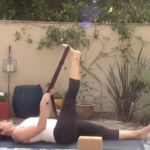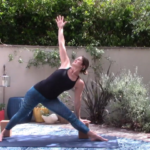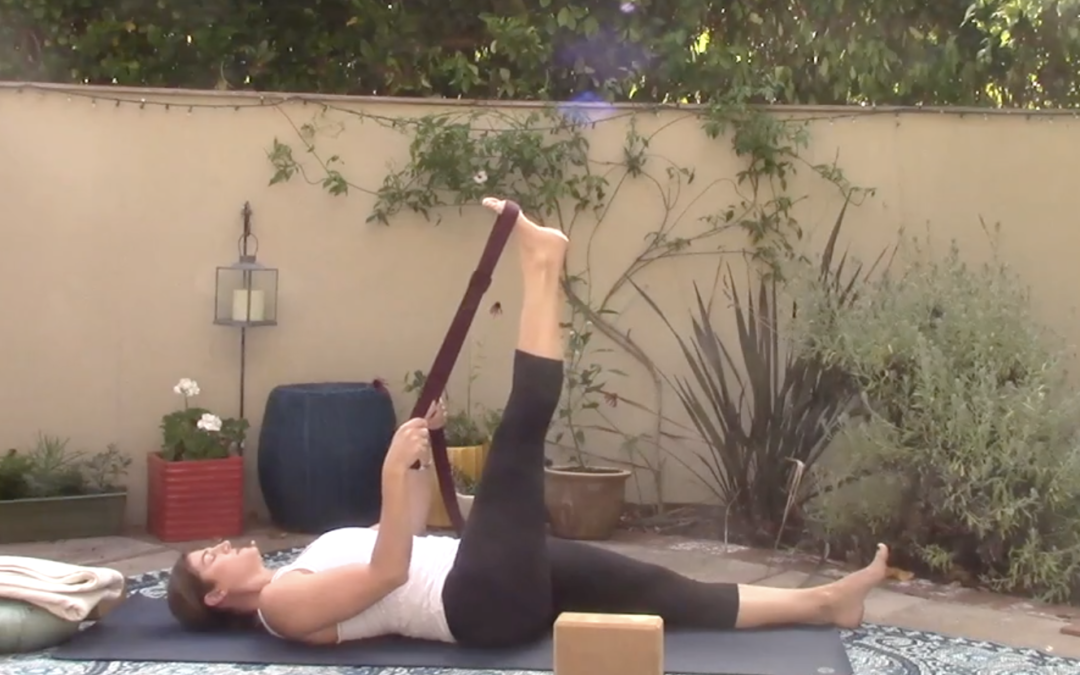Part 1: Pick Longevity Over Sensation
In 2015, I attended a class at Wanderlust in Squaw Valley with Annie Carpenter. This was the first time I heard this specific call from a yoga teacher to work toward LONGEVITY in the asana practice.
As the class began, Annie started us out in Reclined Hand to Big Toe Pose (Supta Padagusthasana).
This is the one where you bring lie down, one knee to the chest and hug it in while extending the bottom leg straight along the floor. In the “full expression” (I’m dropping that language from my teaching, by the way) of the pose, you reach your hand up for your big toe and hold on, which provides a pretty big sensation long the back of the leg for most of us. And then you take the leg out the side for Supta Padagusthasana II.
 If you can’t hold the big toe, the “modification” (another piece of language I’m dropping) is to use a strap around your foot so you can still enjoy some sensation along the back of the leg. See the picture above.
If you can’t hold the big toe, the “modification” (another piece of language I’m dropping) is to use a strap around your foot so you can still enjoy some sensation along the back of the leg. See the picture above.
And this is great. It’s a great passive stretch as you hold on to the foot, either with your hand or with the strap. It can be very relaxing, and can help us feel as if we are releasing tension (a whole other loaded word…blog post for another time).
Typically, the “goal” of this pose has been to get into extreme range of motion. If we were to rate the feeling of sensation we’re going for on a scale from 1 to 10, where 1 is nothing and 10 is the highest sensation of stretch, I would say that most yoga classes have at least subtly emphasized going for at least an 8 or 9.
We tend to hang out at the edge of our range of motion.
But Annie did something different here. She asked us to BACK OFF the sensation in the back of the leg and not bring the top leg in so close to the chest. Instead, she asked us to prioritize the anchoring of the bottom thigh down to the floor, because if we only go for sensation in the back of the top leg, we may end up sacrificing the longevity of our hips. We did some really nice variations on this pose, which I’ll share in a video at the end of this post.
Annie encouraged us to, “For today, prioritize longevity over sensation.”
Well, when you put it like THAT…
Had I had it backwards? I thought sensation was good. All these years of practicing, had I been prioritizing sensation, that deep feeling of stretch, above the long-term health and resiliency of my body?
The rest of the class followed this vein, where Annie asked us continually to BACK OFF and go for more integrated and stronger versions of traditional postures, even if that meant we had to sacrifice our egoic desires to go as far as we could go. For example, to use a block under the bottom hand in Trikonasana (Triangle Pose), even if when we “didn’t need it.” Or to NOT “open the heart” and lean back in Trikonasana even if we felt compelled to do some because it feels so expansive and backbendy and stretchy and lovely to do so.

In one of my group yoga classes at Luma Yoga this week, I taught a more integrated version of Trikonasana where we really tried to find some more engagement in the core and not lean into the backbendy version. One of my super-bendy students (some may describe her as hypermobile, a camp that may yogis fall into) asked, “So should I NOT lean back and open up in this pose? It feels so good? I find it so relaxing to do that…If I’m not allowed to do that, then how can I relax in yoga?”
Such a good question. I love this question. Because I struggle with it myself. Many of us who are on the stretchier side really LOVE the feeling of sensation that yoga gives to us. Sometimes have to go quite far to feel much of anything. My nervous system may feel completely safe and comfy stretching my leg straight in Trikonasana and leaning back and there is a feeling of release. Another person’s nervous system kicks in WAY before that stage to protect the body, and they can’t even imagine what I’m even talking about here.
So the questions come.
- Why are we doing these postures?
- Is there magic in the postures themselves?
- Is there MORE magic in the “full expression” of the postures?
- Is passive stretching good for us?
- It is better to be able to touch your toes than not?
- What is the benefit of being super flexible?
- Is being strong in yoga important?
- Why are we coming to yoga in the first place?
- Is there a way to use the practice to help our body be more resilient (stronger) and more at ease (safely relaxed)?
- And will this resiliency and ease bring us closer to knowing ourselves more deeply?
In Patanjali’s Yoga Sutras, Patanjali lists 9 distractions that “stir up consciousness” and “act as barriers to stillness.” One of these is sickness. You can think of it also as pain.
As we all know, it can be very difficult if not impossible to sit in meditation and calm the mind so that we can feel the unity of our individual expression of energy with that of the collective when we are in physical pain. It’s distracting, right?
And even if we are not practicing yoga in the interest of coming into closer union with a power beyond ourselves, however you define that, my experience is that most everyone coming to the yoga practice is interested in feeling better in their body and finding a sense of calm and settling the mind.
So pain management and modulation is one of the main goals that I think many students have when they come to the practice of yoga. And I think it does a good job of it. Many of us who sit in desks all day or do other forms of extreme activity like running, biking, crossfit, hiking, etc. NEED the relaxing effects of yoga and the stretching that it provides.
But if yoga done through passive stretching alone is ALL we do, then we may not be well served over many years of intense practice.
Well, the middle road is usually a good path to take.
I have come to believe that ONLY passive stretching maybe actually hurting us in the long run and can move us toward pain if we’re not careful, especially those of us who tend to be stretchier. The good news is that the practice of yoga as it’s been done in past several decades has GREAT capacity for slight shifts to move in different way and encourage more STRENGTH. And this work is good for ALL of us, even those of us who are “stiffer.” Did you know that creating more integrated bodies and doing strength work so that our bodies work well for us in all kinds of movement actually creates more MOBILITY?? As our bodies strengthen, areas where we may be gripping can start to relax as our nervous system feels safer.
So everyone wins. We all want to be able to bend down to tie our shoes or to reach up and get something off a high shelf or to catch ourselves if we slip on an icy sidewalk and not get injured.
Our body has the capacity to support us in LIFE. We just need to learn to work in slightly different ways.
So how do we shift it? From Annie’s class in 2015, I would spend 2 more years dealing with the hip-click, and it wasn’t until last summer when I learned about skeletal variation, functional movement, biomechanics, and the 3D model of the body, and how loading tissues work with Valerie Moselle that I would really find some answers.
In my next blog post, I’ll share my recent learnings, the amazing people out there in the yoga and movement world that are inspiring me, and the work I’m now incorporating into my practice, my group classes and the private sessions I teach.
For now, though, try shifting your Supta Padagustasana slightly in these ways:
- Try to ground the bottom thigh down to the ground, making that the priority in this pose rather than going for a passive hamstring stretch. Adding a strap will be necessary for many of us, because the bottom thigh tends to lift up when we reach for the big toe and take the leg in closer (of course, a lot of this depends on the length of our legs and arms, and how our pelvis is put together).
- Next, we work on ACTIVATING the muscles on the backs of the legs to contract them, which will aid in strengthening these muscles, AND will help to develop more mobility in the hamstrings. To do this, you’ll do a slight “hamstring curl” with your foot in the strap, like your trying to draw your heel toward your seat without actually moving your foot a lot. This is an isometric contraction (the muscle is contracting but the joint position doesn’t change).
- Now, we’ll fire up the muscles in the core by hovering the bottom leg just above the floor and releasing the hands from the strap, taking the arms overhead. Hold here for 5 smooth breaths into the rib cage, keeping the belly strong and the front bottom ribs down.
- Finally, bring the hands back to the strap and open the top leg out to the side. Try to keep the hip points EVEN with one another. This is usually pretty tough! Then release the strap while the leg is out to the side, and use the muscles on the inner leg to actively lift the leg back to center. Repeat a few times.
- Release the leg and feel your legs. What got activated? Where did you struggle? What was the sensation like?
Another way to play with this pose is to look for LESS sensation that we normally go for. When I guide my private students through this Reclined Hand to Big Toe Pose with a strap or in an assisted version with me playing the role of the strap, I will often help them to find a level of sensation between 4 and 6 on a scale of 1 to 10. The idea here is that when our nervous system feels safe and at ease, our body can relax more fully and muscles that way be subconsciously contracting can let go of that contraction, which has the sensation of letting go.
One of my private students says, after we do this work, that the leg that we’ve moved feels heavier, longer, more connected, and SPARKILY. Doesn’t that sound worthwhile?
How did it go? Let me know in the comments!
Read Part 2: What I’m doing to shift my yoga practice ever so slightly to trust my body’s intelligence again


 Empowering women who are 40+ to install movement habits that are nourishing, strengthening, and approachable for a truly calm and connected life.
Empowering women who are 40+ to install movement habits that are nourishing, strengthening, and approachable for a truly calm and connected life.
This is a very balanced view of the practice. More and more in my own practice and teaching am I going deeper in and finding the grounding, expansive, roots of what is being created in the asana. I really appreciate the subtle shifts in this supta padagusthasana series to maintain the strength of the hips along with the alignment and stretch. Wonderfully presented, again, Robin! Jodi
I’m so glad this resonates with you, Jodi! I love what we are all learning as a community about what it means to go deeper, and how this can shift into ever-evolving layers of awareness. Love to you!